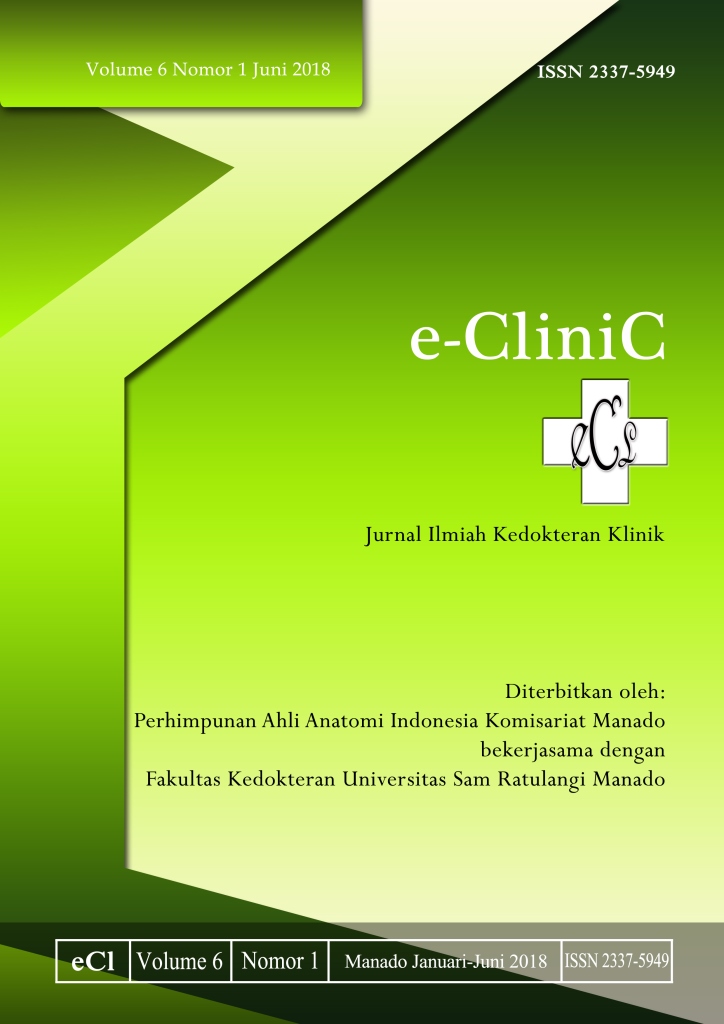Insiden dan Mortalitas Penderita Kanker Serviks di RSUP Prof. Dr. R. D. Kandou Periode Januari 2014 - September 2015
DOI:
https://doi.org/10.35790/ecl.v6i1.19501Abstract
Abstract: Cervical cancer is caused by human papiloma virus (HPV). It is a malignant disease in obstetrics and gynecology field which still occupies the highest position cancer among females woman. This study was aimed to obtain the incidence and mortality of cervical cancer patients at Prof. Dr. R. D. Kandou Hospital Manado from january 2014- september 2015. This was a descriptivease retrospective study using patients’ medical record data of cervical cancer. The results showed that there were 121 patients of cervical cancer, most were in the age group of 41-50 years (39.67%) and stage III B (41 people; 33.89%); 23 patients (19.00%) died. Conclusion: The incidence of cervical cancer at Prof. Dr. R. D. Kandou Hospital Manado was high enough with a mortality rate of 19.00%.
Keywords: cervical cancer
Â
Abstrak: Kanker serviks disebabkan oleh Human Papiloma Virus (HPV) dan merupakan salah satu penyakit keganasan di bidang obstetrik dan ginekologi yang masih menempati posisi tertinggi sebagai penyakit kanker yang menyerang kaum perempuan. Penelitian ini bertujuan untuk mengetahui insiden dan mortalitas pasien kanker serviks di RSUP Prof. Dr. R. D. Kandou Manado sejak Januari 2014-Septemper 2015. Jenis penelitian ialah deskriptif retrospektif dengan menggunakan data rekam medik pasien kanker serviks. Hasil penelitian mendapatkan 121 kasus kanker serviks, terbanyak pada kelompok usia 41-50 tahun (39,67%). Kebanyakan pasien berada pada stadium IIIB sebanyak 41 orang (33,89%) dan 23 penderita (19,00%) dinyatakan meninggal dunia. Simpulan: Insiden penderita kanker serviks di RSUP Prof. Dr. R. D. Kandou Manado cukup tinggi dengan angka mortalitas sebesar 19,00%.
Kata kunci: kanker serviks
Downloads
How to Cite
Issue
Section
License
COPYRIGHT
Authors who publish with this journal agree to the following terms:
Authors hold their copyright and grant this journal the privilege of first publication, with the work simultaneously licensed under a Creative Commons Attribution License that permits others to impart the work with an acknowledgment of the work's origin and initial publication by this journal.
Authors can enter into separate or additional contractual arrangements for the non-exclusive distribution of the journal's published version of the work (for example, post it to an institutional repository or publish it in a book), with an acknowledgment of its underlying publication in this journal.
Authors are permitted and encouraged to post their work online (for example, in institutional repositories or on their website) as it can lead to productive exchanges, as well as earlier and greater citation of the published work (See The Effect of Open Access).







